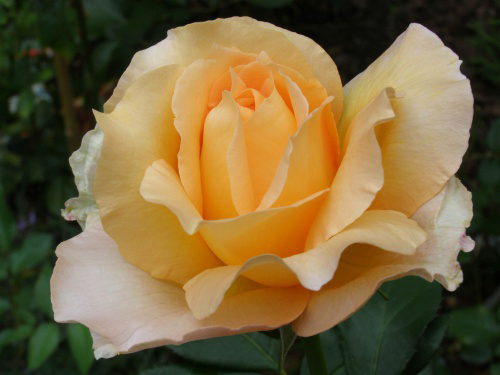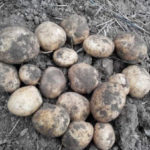Rosa Casanova
It's hard not to recognize the grace and charm of hybrid tea roses. Many varieties of this group are simply charming. A striking example is the wonderful variety of Casanova. It has many advantages: a beautiful, delicate shade of petals, long flowering and good resistance to winter cold.

History of creation and description of the variety
The variety, about which our story will go, appeared in the field of vision of flower growers in 1964. It was created in the McGrady rose nursery, located in Northern Ireland and founded by a family of local breeders back in the 80s of the XIX century.
This decorative perennial grows in the form of a powerful bush with strong, erect shoots of green-brown color, equipped with a small number of hook-shaped, large thorns. Its leathery, light green leaves have a not too pronounced glossy sheen. In height Casanova reaches 1, maximum 1.2 meters. The width of the crown of the rose is 70 cm. The flowers, which form one by one on the stems of the plant, are double and rather large: from 14 to 16 cm in diameter. Their color can be described as warm yellow with tea, lemon, straw or cream shades. The edges are in lighter colors. In addition, there is a slight blush on the silky petals. The buds are pointed. Each of them contains 38-40 petals. The aroma of lovely flowers is rich and pleasant. The noble plant blooms for a long time, profusely, from the end of June to the first autumn frosts. Casanova belongs to the multi-flowering varieties. The disadvantages of fragrant perennial flowers are the thinness of the petals, their rapid shedding when hot summer weather sets in, and a high degree of rain damage.
The plant can withstand temperatures as low as -23 ° C. The rose is quite susceptible to fungal diseases, and more to black spot than to powdery mildew.

Features of agricultural technology
A cultivar with a memorable name should be placed in the sunny sector of the site. It grows well in partial shade, but it cannot stand the shadow at all, unable to bloom at such a low level of illumination. The site chosen for planting the crop must be reliably protected from cold, gusty winds. You cannot plant a shrub in a lowland - there it will undergo stagnation of moisture, which will sooner or later rot and, as a result, die.
Perennial is picky about the soil. It should be planted only in fertile, moisture-consuming, loose and light soil with a slightly acidic reaction. The best option for a rose is loam. Before planting, the lower part of the seedling is immersed in water for 2 hours. A pit is prepared on the site with a depth of 30 to 50 cm.If you plan to place several Casanova bushes, keep a distance of at least half a meter between them. After laying at the bottom of the drainage hole, fertilizer is applied to the pit, which is sprinkled with earth. Now you can proceed directly to planting the plant. At the end of this event, do not forget to water the culture at the root, having previously tamped the ground around it.
It is necessary to supply the Irish beauty Casanova with moisture regularly, in moderate, and in hot weather - in an intensive mode. Up to 2 buckets of settled, slightly warm water are spent on an adult shrub. In summer, when it is hot, it will not be superfluous to humidify the air around the rose by spraying liquid near the crop with a spray bottle. Make sure that no water gets on the flower petals! During the growing season, the tea hybrid needs additional feeding. In spring, nitrogen fertilizer is applied under the rose bush, during the formation of buds on the plant, as well as at the peak of flowering of an ornamental perennial, it is fed with a mineral complex containing a large amount of potassium and phosphorus.

Some time after watering, the soil in the zone of the trunk circle is loosened and mulched with humus or peat. The first procedure ensures a normal supply of oxygen to the roots of the plant, prevents the appearance of weeds.Mulching is carried out with the aim of long-term preservation in the soil under the flower of moisture and to protect the earth from overheating.
Rose pruning is carried out in spring and autumn. Spring activity should be moderate. In the first year of life, shoots on the culture are shortened by several buds. In the future, the branches are cut into 5-7 buds. Dry and frozen shoots are removed. In the summer, it is not forbidden to carry out stimulating pruning, and it is also important to remove faded buds in time. Before the onset of winter, unripe shoots are cut out, foliage is cut off. Then they spud the plant with peat and cover it with spruce branches. The culture will be protected from diseases and insect pests by preventive treatment with insecticidal and fungicidal preparations.
Use cases
Variety Casanova can be grown in groups, placed alone on a grassy lawn. It looks great in mixborders, ridges, on round flower beds. Any landscape compositions with this noble plant are simply magnificent! Good companions for this rose are irises, daylilies, phloxes, geraniums, clematis, heuchera, petunias. The beauty of the Irish sissy will be emphasized by cereals, aromatic herbs and decorative leafy crops. The rose also looks great in combination with miniature conifers. The delicate flowers of Casanova are used for cutting.








